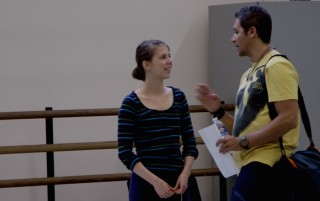Title

Cleo Person, a Summer Dance resident assistant, consults with faculty member Francisco Martinez.
(Photo by Juilliard Journal)It was just before 10 on a mid-July Saturday morning, one week into Juilliard’s three-week summer dance program for high schoolers. Half of the 45 students were warming up for a master class with Juilliard alumna—and one of the program’s choreographers—Loni Landon. As one of the students’ counselors, I was taking the class as well, and arrived before Loni did. The students were clustered in small groups around the edges of the room, stretching or discreetly chatting. It wasn’t long before I sensed their apprehension. They had heard that the class would be improvisatory, and that was unfamiliar territory for many of them—plus it was the end of a week that had been packed with copious amounts of new information, and their confidence levels seemed a little low. And then Loni glided in, buoyant with her energy of chill geniality and surrounded by her usual aura of animal-like physical sensitivity. A little warily, the dancers began to gather in the center of the room, and after setting up her music and pulling on her black socks, Loni turned to face them.
Body
“We’re just going to warm up really slowly since it’s Saturday morning. Don’t place any judgments on yourself or what you’re doing,” she recommended, perhaps sensing their trepidation. “Just really listen and respond.”
An hour and a half later, sweat was flying and bodies were tearing through space with thrilling abandon but also catlike control. The dancers were reacting to each other with seemingly choreographed precision, and yet it was all impulse and spontaneity: improvisation. Great changes, more profound than just temperature and humidity, had miraculously been effected.
“You moved incredibly! You were such an animal!” The pre-class hush was gone as the dancers congratulated each other after class. (In dancer terms, being called an animal is usually a really good thing; it means you move fearlessly and ferociously.)
“I’ve never moved like that before!” one young dancer told me afterward. “I didn’t even know I could!” Yet in the context of the surrounding weeks, an event like this was nothing too out of the ordinary. In fact, huge leaps in self-perception, trust, and knowledge seemed to be at least daily occurrences on the third floor of the Juilliard building this summer.
For these 15- to 17-year-old dancers from around the country and the world (Israel, Italy, South Africa, and Australia were all represented), some of whom had previously trained only in ballet or competition dance, these weeks in New York were a chance to explore Juilliard dance training, with its shared emphasis on classical, modern, and contemporary dance. This annual summer “camp” offers dedicated students an opportunity certainly to grow physically—the intense daily hours of dancing last from 9 a.m. to dinnertime—and to push boundaries of stamina and technique. But perhaps even more crucially, it gives hungry, curious students to a chance to expand mentally—to open themselves to new information, ways of working, and ways of thinking about the art form as well as themselves. It is especially this mental shift that they can take back home to continue working on once the three short weeks are finished.
Another great aspect of Summer Dance Intensive is that it gives those who may be interested in coming to Juilliard a pretty authentic taste of what it’s like to go to college here. Many strange rumors about Juilliard circulate in the outside world, but when the dancers have the opportunity to experience Juilliard’s environment and meet some current students (11 of us serve as resident assistants and class assistants for the program) they realize that far from harboring feelings of cutthroat animosity, students here actually really like and support each other. And they see that, contrary to other rumors, we don’t all have eating disorders and the teachers aren’t out to get us, but instead have each student’s best interests at heart.
Working as one of the resident assistants this summer, I had fun answering the dancers’ questions, helping paint the most authentic picture possible of conservatory life, and leading them through the everyday routine of life at Juilliard. My fellow counselors and I gave them plenty of tips about living in the dorm (bathroom cleaning included), navigating the cafeteria, and managing the vigorous class schedule.
I know for a fact that Summer Dance can be pretty intense for the participants, some of whom have never before been to New York City, or even away from home for much time. That was the case when I came to Summer Dance Intensive after my freshman year in high school. The young dancers’ challenges, as well as their excitements, felt intimately familiar to me as I watched them fill the same shoes I had danced in four years earlier. Homesickness? I’ve been there. Rehearsal anxiety? I had to learn some methods to quell that, too.
Watching the next batch of aspiring Juilliard dancers, I had a moment of extraordinary insight into how much my time so far at Juilliard has helped me to evolve and mature. If there’s one idea I hope the dancers have been able to take away from the summer, it’s that that process never stops. The moments they felt of growth and expansion, evolution and maturation, discovery and insight, are just the beginning of what I hope, for them and for me, will be some of many, many more to come.




